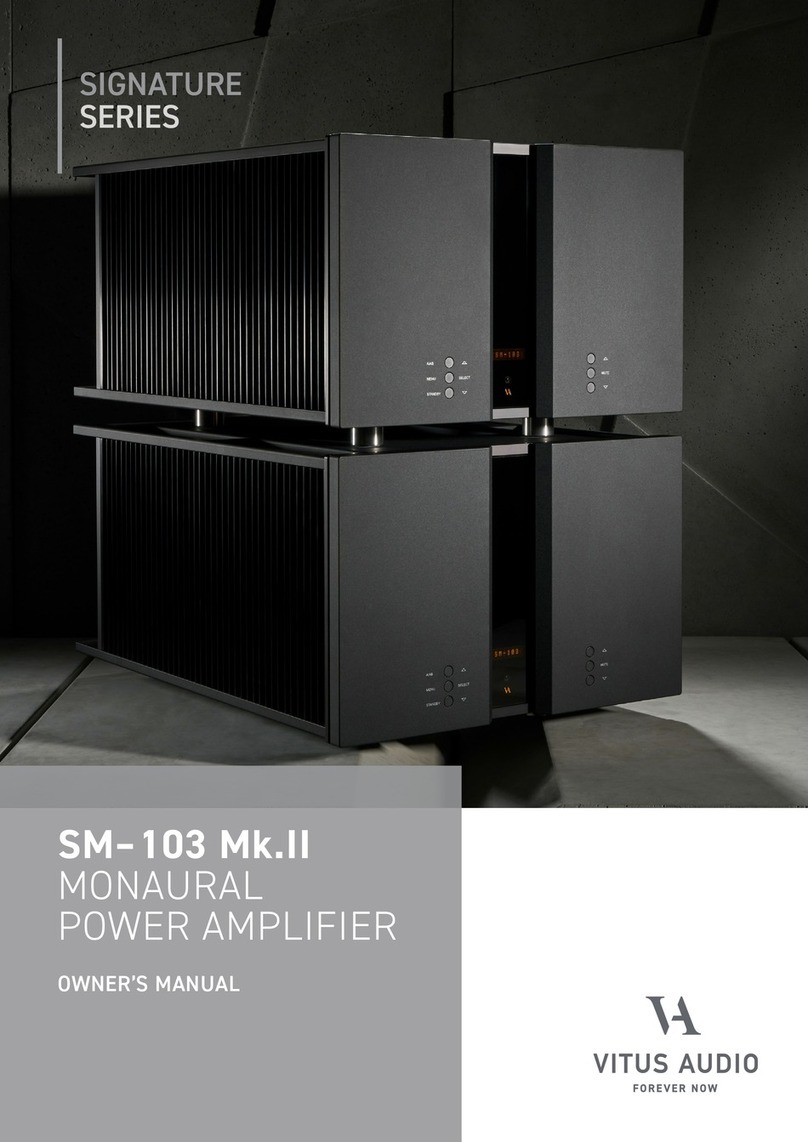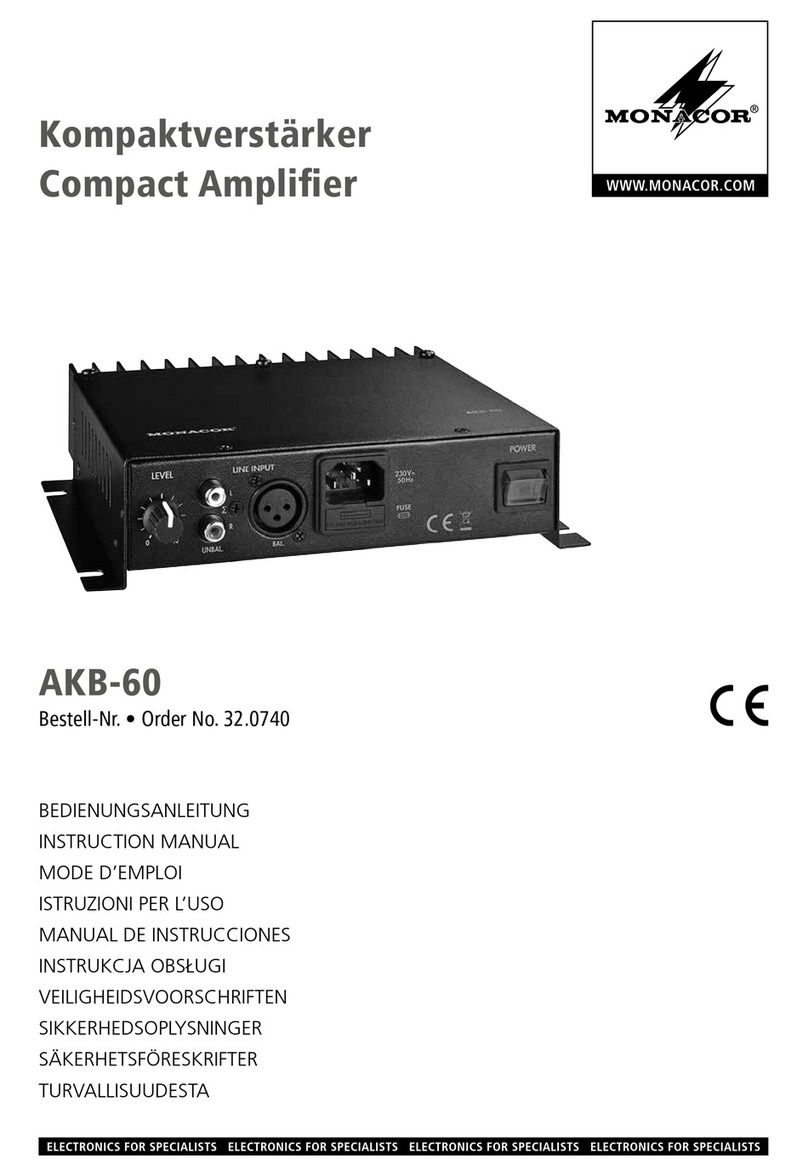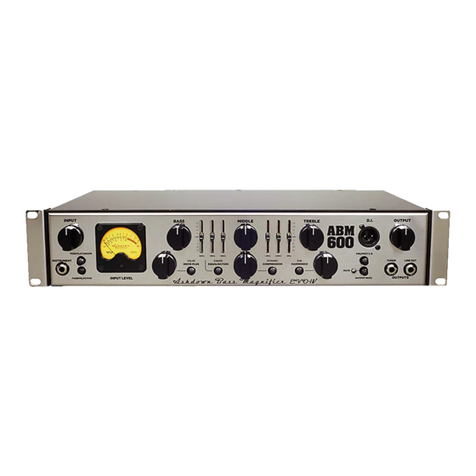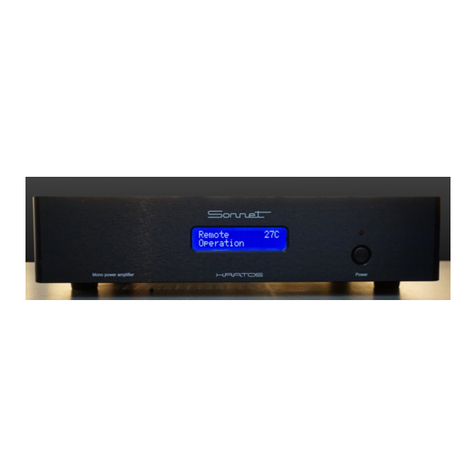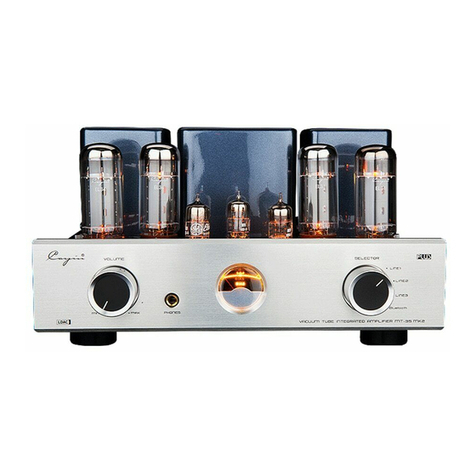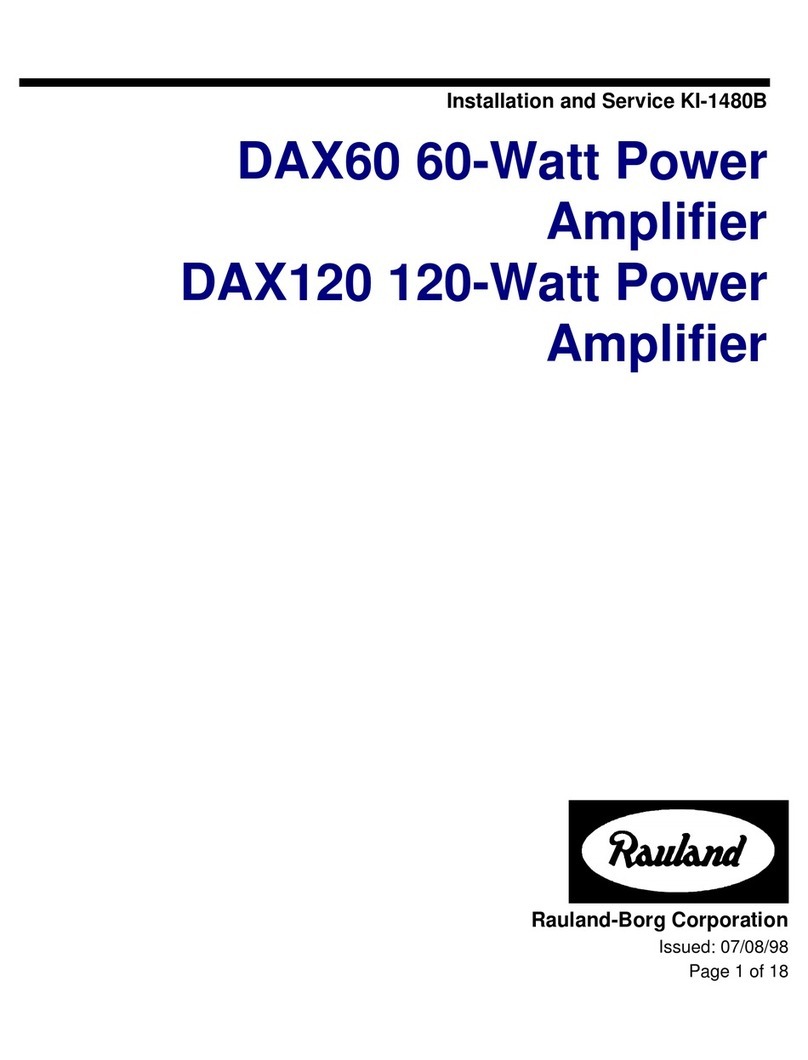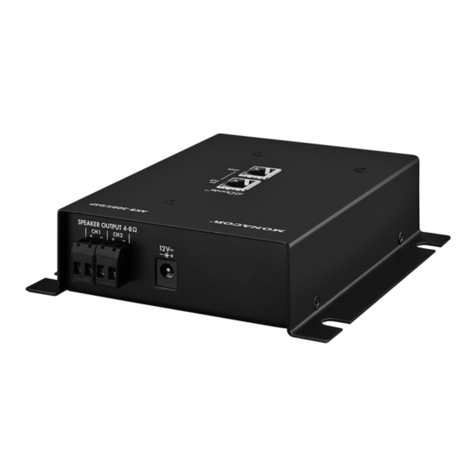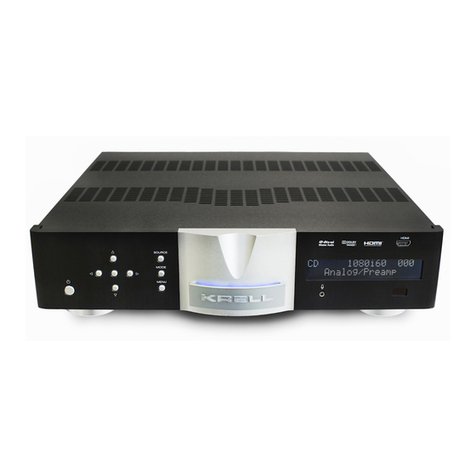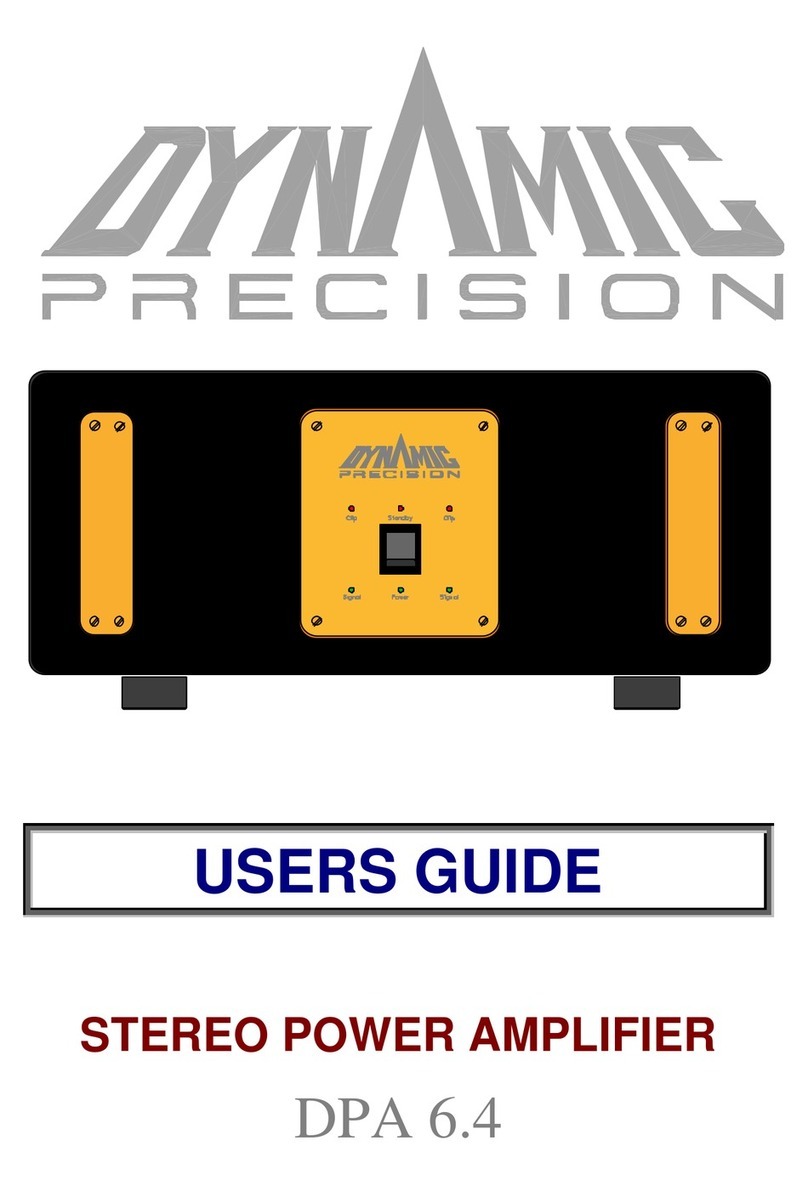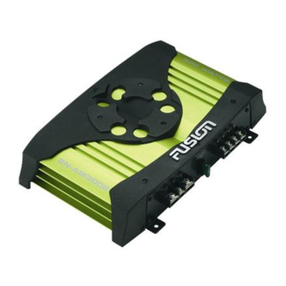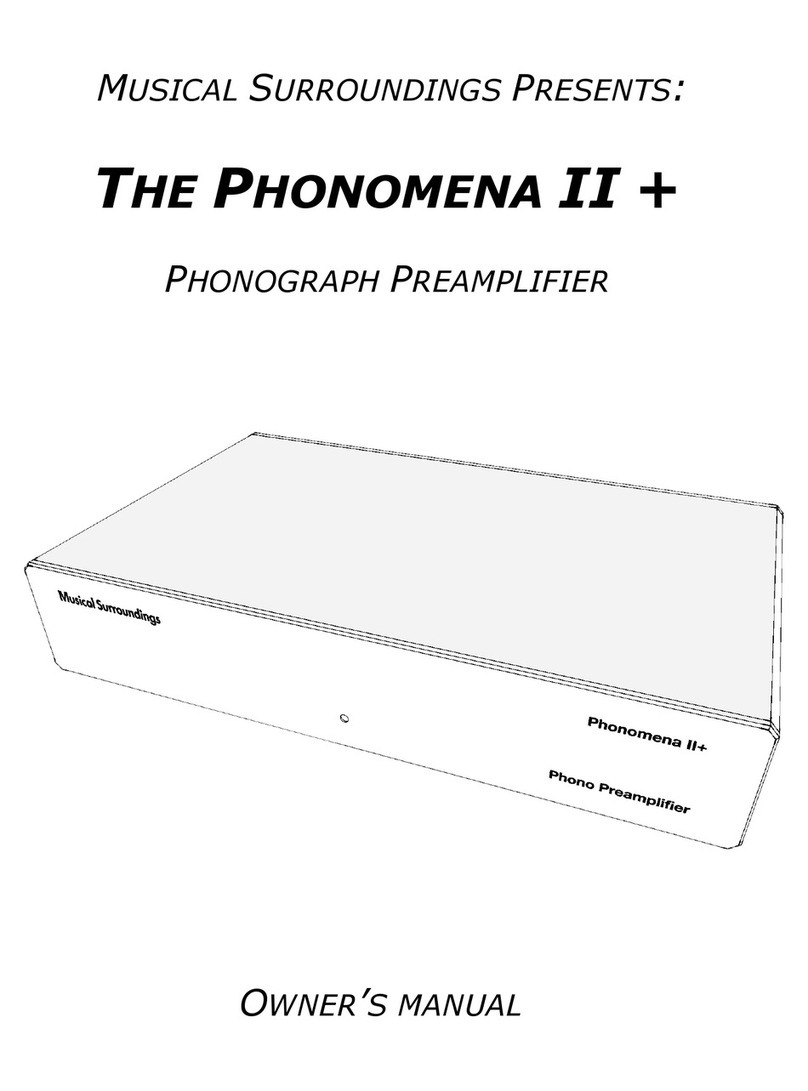SRK FMA300 User manual

(ACN 089 050 564 ABN 44 089 050 564)
8 Victoria Grove
Hawthorn East
VIC 3123
Australia

FMA 300 Manual
2003 SRK Electronics Pty Ltd
FMA300 Manual
Safety notice
1 General description
2 Unpacking
3 Installation
4 Operation
4.1 Front view
4.2 Rear view
4.3 Switching on and off
4.4 Setting output power
4.5 Setting channel frequency
4.6 Setting audio gain
4.7 Selecting pre-emphasis and input impedance
4.8 Enabling/disabling stereo
4.9 SCA option
4.10 Protection
4.11 Remote operation
4.12 Audio limiter
4.13 Amplifier metering
5 Maintenance
5.1 Recommended maintenance schedule
6 Circuit description
6.1 Equipment overview
6.2 Amplifier
6.3 Control Board
Drawings

FMA 300 Manual
2003 SRK Electronics Pty Ltd
Safety note
This equipment uses high voltages internally. Any servicing should be performed by
competent individuals.
Prolonged exposure to high level RF radiation has been shown to pose a health risk.
Whilst the equipment is intrinsically safe, its use in conjunction with an antenna
system may generate large RF fields. Appropriate precautions should be taken by
individuals that habitually work close to the transmitting antenna.
The RF power devices of this equipment employ Beryllium Oxide. This substance is
extremely toxic if pulverised. On no account should any RF power devices be
smashed. Please refer to attached Material Safety Data Sheet for further information.
WARNING
THIS EQUIPMENT IS SUPPLIED WITH A MAINS LEAD INCORPORATING
AN EARTH WIRE. IT IS IMPERATIVE THAT THIS EQUIPMENT IS
CONNECTED TO A MAINS OUTLET THAT HAS AN EARTH. IN
COUNTRIES WHERE EARTHED OUTLETS ARE NOT MANDATORY, IT IS
THE CUSTOMER’S RESPONSIBILITY TO ENSURE THAT THIS
EQUIPMENT IS APPROPRIATELY EARTHED.

FMA 300 Manual
2003 SRK Electronics Pty Ltd
1 GENERAL DESCRIPTION
The FMA300 is a high quality 300W amplifier intended for audio broadcast service in the FM
band.
Its features include:
•Frequency agile.
•Extensive self test and auto diagnostics.
•Rugged design.
•Conservatively rated.
Applications include low power broadcast, narrowcast, community broadcast, rebroadcast for
tunnels, student radio stations and as a driver for high power transmitters.
The FMA300 is designed and built in Australia.

FMA 300 Manual
2003 SRK Electronics Pty Ltd
2 UNPACKING
This section details the way in which the FMA300 should be unpacked upon receipt by the
customer.
Upon receipt the amplifier should be visually inspected to ensure that no damage has
occurred in transit.
Along with the amplifier, the following items should also be present:
•This manual
•Mains lead
The customer should ensure that all items are present and then store them in a safe place.

FMA 300 Manual
2003 SRK Electronics Pty Ltd
3 INSTALLATION
3.1 General
This section describes the installation and infrastructure requirements for the FMA300.
Departure from the instructions contained herein may void any warranty provided by SRK.
3.2 Environmental
The transmitter is intended for indoor use. The transmitter should be protected from rainfall
and direct sunlight, extremes of temperature and humidity and from conditions of high dust
levels. Ambient temperature should be in the range +10°C and +30°C. The transmitter shall
not be operated at altitudes in excess of 3500m above sea level. The transmitter must be
installed on a flat, stable surface. The transmitter must be installed in the upright position.
The transmitter must be installed in a location free from vermin and the ingress of other
animals. The transmitter shall not be installed in locations prone to flooding. All ventilation
orifices must be clear to allow adequate air flow.
3.3 Electrical supply
The electrical supply to the transmitter must be of the voltage, form and frequency described
in the specifications. All electrical wiring must be carried out in accordance with local laws,
standards and regulations. If power supply voltages regularly fall outside specifications then
a voltage regulator must be installed between the supply inlet and the transmitter.
3.4 Earthing
Adequate earthing of the transmitter is vital to ensure long term reliability and user safety.
The electrical supply must be earthed, via the earthing pin of the IEC connector. In countries
where power outlet earthing is merely optional, an earthed outlet must be used. See safety
notice at the front of this manual. A separate, independent, earth is required for the
transmitter/antenna system and must be connected to the earthing point indicated on the rear
of the transmitter. The cable used to connect the earth should be as thick as possible, with 8
AWG being the smallest size acceptable. Where possible, broad earthing band should be
used.
In addition to the earth connection to the transmitter, the outer conductor of the coax feed to
the antenna should be connected to the earth, as indicated below.
The earth itself must be of high quality buried copper, at least 1.5m deep and preferably in
ground that is habitually humid (eg, the base of a gutter down pipe).

FMA 300 Manual
2003 SRK Electronics Pty Ltd
3.5 Antenna
The antenna load connected to the transmitter must be tuned to minimise reflections. Whilst
the transmitter is designed to withstand high levels of reflection for short periods, continually
high levels of reflected power will degrade the long term reliability of the transmitter.
Operating SWR should be kept to below 1.9:1.

FMA 300 Manual
2003 SRK Electronics Pty Ltd
4 OPERATION
4.1 Front View
Please refer to figure 4.1. The numbers of the following paragraphs refer to the controls
shown in figure 4.1.
1 Auxiliary power indicators
These three LEDs indicate that the +5V,+15V and –15V auxiliary supplies generated within
the amplifier are present.
2 Amplifier meter
Displays various internal parameters of the amplifier, as determined by the meter parameter
panel (5).
3 Alarm indicators
When lit, these indicators show that an alarm or failure condition exists. The cause of any
alarm should be investigated.
4 Air inlets
These inlets allow air to enter the amplifier for cooling and must not be obstructed..
5 Meter parameter panel
This indicates which parameter is currently being displayed on the meter.
6 Meter parameter button
Pressing this button causes the meter to display the next parameter, shown on the meter
parameter panel.
4.2 Rear View.
Please refer to figure 4.2. The numbers of the following paragraphs refer to the controls
shown in figure 4.2
7 RF out
This is the RF output connector and mates with a male N type.
8 Amplifier forced air exhaust
This is the exit port for the forced air cooling. Do not obstruct.

FMA 300 Manual
2003 SRK Electronics Pty Ltd
9 Mains input.
Mains input. 240VAC single phase.
10 Mains circuit breaker
This is the mains circuit breaker for the amplifier. 5A.
11 Mains on-off switch.
Switches the amplifier on and off.
12 Earth stud.
This is the main earth stud. To this must be made the earth connection.
13 Remote control.
Allows remote monitoring of amplifier status. This mates with and 9 way D type plug.
14 RF in
This is the RF input connector and mates with a male N type.
15 Mains neon.
Lights when the unit is switched on and mains is present.
4.3 Switching on and off
The FMA300 is switched on by depressing the power switch (11) to the up position.
If mains voltage is present then the adjacent neon should illuminate.
The fans will start, the auxiliary power indicators will light and the panel meter will indicate
forward output power
Output power is set by the exciter drive power.
Note that there is an interlock function so that if RF is present on the input of the amplifier at
power on, the “HIGH I/P POWER” alarm will light and the amplifier shut down. Ensure that
the RF drive is applied after the amplifier is switched on.
The FMA300 may be switched off at any time by depressing the power switch to the down
position.
4.4 Setting output power
See FMX25 manual. Transmitter power is simply set by exciter power. Use the meter on the
amplifier to monitor forward and reflected RF power.

FMA 300 Manual
2003 SRK Electronics Pty Ltd
4.5 Setting Channel Frequency
See FMX25 manual. Note that it is advisable to reduce RF power to zero before changing
frequency, then ramping power back up at the new frequency.
4.6 Setting audio gain
See FMX25 manual.
4.7 Selecting pre-emphasis and input impedance.
See FMX25 manual.
4.8 Enabling/disabling stereo.
See FMX25 manual.
4.9 SCA option.
See FMX25 manual.
4.10 Protection
The FMA300 incorporates a number of protective features that make it extremely rugged.
If the reflected power from the antenna exceeds 30W then the output RF power will be
automatically reduced to bring the reflected power back to 30W. Under this condition the
FMA300 will continue to function, albeit at a reduced output power, indefinitely until the
reflected power reduces. The amplifier alarm LED “HIGH SWR” will light.
If the temperature of the RF amplifier becomes excessive (>85ºC), then the RF output power
will be reduced to zero until the amplifier temperature falls to an acceptable level. During this
time the amplifier alarm LED “HIGH TEMPERATURE” will light.
If the RF output power exceeds 330W then the amplifier will limit power to about 330W. The
amplifier alarm LED “HIGH O/P POWER” will light.
If the RF input power exceeds about 10W then the amplifier will shut down until the RF power
drops to less than 4W. During this time the amplifier alarm LED “HIGH I/P POWER” will light.
See also the relevant sections of the FMX25 manual.
All error conditions are recoverable automatically once the cause of the error has been
removed. No user intervention is required.

FMA 300 Manual
2003 SRK Electronics Pty Ltd
4.11 Remote operation.
The FMA300 may be monitored remotely via the “TELEMTRY” connector on the rear of the
unit. This is an RS232 standard connection with the following characteristics:
Baud rate: 9600
Data bits: 8
Parity: NONE
Stop bits: 1
Flow control: NONE
The pinout for the DB9 connector is as follows: pin 2, transmit data, pin 3, receive data, pin 5,
common (0V). All other pins are not connected.
The FMA300 responds to the following commands. <CR> indicates the ASCII character 0D
hex. All letters are upper case, spaces (20 hex) are indicated by “_”. All commands must be
terminated by <CR>. Note that a line feed (0A hex) must not be sent before or after <CR>.
After a response is sent, a carriage return, line feed and “>” are sent.
FP?<CR>
Returns forward power in the form XXXW<LF><CR>>. For example:
FP?<CR> (command)
300W<LF><CR> (response from amplifier)
>
Note that for forward powers of 99W and below, the leading zero is replaced with a space
RP?<CR>
Returns reflected power in the form XXXW<LF><CR>>. For example:
RP?<CR> (command)
_00W<LF><CR> (response from amplifier)
>
Note that for reflected powers of 99W and below, the leading zero is replaced with a space.
IP?<CR>
Returns the input power in the form XX.XW<LF><CR>>. For example:
IP?<CR> (command)
_7.5W<LF><CR> (response from amplifier)
>
Note that for input powers of 9.9W and below, the leading zero is replaced with a space.
AT?<CR>
Returns the amplifier heatsink temperature in the form XXXC<LF><CR>>. For example:
AAT?<CR> (command)
_32C<LF><CR> (response from amplifier)
>
Note that for temperatures of 99C and below, the leading zero is replaced with a space.
AI?<CR>

FMA 300 Manual
2003 SRK Electronics Pty Ltd
Returns amplifier DC current in the form XX.XA<LF><CR>>. For example:
AAI?<CR> (command)
_7.5A<LF><CR> (response from amplifier)
>
Note that for currents of 9.9A and below, the leading zero is replaced with a space.
PT?<CR>
Returns the PSU temperature in the form XXXC<LF><CR>>. For example:
PT?<CR> (command)
_32C<LF><CR> (response from amplifier)
>
Note that for temperatures of 99C and below, the leading zero is replaced with a space.
AV?<CR>
Returns the amplifier DC supply voltage in the form XX.XV<LF><CR>>. For example:
AV?<CR> (command)
50.1V<LF><CR> (response from amplifier)
>
Note that for voltages of 9.9V and below, the leading zero is replaced with a space.
BS?<CR>
Returns the current self test status in the form XXX<LF><CR>>, where X can be either 0 or 1.
A 1 indicates a failure, a 0 indicates a pass. The first byte indicates high temperature, the
second indicates a high input RF condition, the third indicates a high SWR condition and the
fourth indicates a high RF output power condition. For further information consult the section
on protection. For example:
BS?<CR>(command)
0010<LF><CR> (response from amplifier indicating a high SWR condition)
>
or
0000<LF><CR> (response from amplifier indicating no failures)
>
HP?<CR>
Returns a summery of the above commands.
Any data received by the amplifier, other than the commands listed above will generate the
following error string:
Invalid_command.__Send_HP?(CR)_for_command_syntax.<LF><CR>
>
Should it be necessary to make connection to the remote port using cables running external
to the building housing the FMA300, it is recommended that external filtering and transient
protection be installed on these lines.
4.12 Audio limiter

FMA 300 Manual
2003 SRK Electronics Pty Ltd
See FMX25 manual.
4.13 Amplifier metering.
The FMA300 has extensive metering to allow a number of parameters to be monitored. The
parameter to be measured is selected by depressing the meter selection switch until the
desired parameter is indicated by the array of lamps next to the switch. Each press of the
button selects the next parameter. The following parameters may be measured:
Forward output power.
The forward output power of the amplifier is displayed in watts, 300W maximum.
Reverse output power.
The reverse output power of the amplifier is displayed in watts, 30W maximum.
Forward input power.
The RF input power is displayed in watts, 10.0W maximum .
Amplifier temperature.
The heatsink temperature of the RF amplifier is displayed in degrees centigrade.
PSU temperature.
The heatsink temperature of the PSU is displayed in degrees centigrade.
Amplifier voltage.
The supply voltage of the amplifier is displayed in volts.
Amplifier current
The supply current of the amplifier is displayed in amps, 10.0A maximum.

FMA 300 Manual
2003 SRK Electronics Pty Ltd
5 MAINTENANCE
5.1 Recommended maintenance schedule
The FMA300 will give many years of trouble free service with little attention. However, it is
recommended to clean the fan filters once per year. This can be done by switching off the
transmitter and unclipping the plastic fan guards on the front of the unit. The filters may be
washed gently on clean, warm water and then dried before re-fitting.

FMA 300 Manual
2003 SRK Electronics Pty Ltd
6 CIRCUIT DESCRIPTION
6.1 Equipment Overview
The FMA300 consists of the following sub-assemblies:
•50V Switch mode PSU
•300W RF amplifier
•Control board
•Output directional coupler
•Auxiliary PSU
These assemblies are interconnected as per “FMA300 wiring diagram”.
The 50V SMPSU generates 50V at up to 10A for the RF amplifier. It incorporates inrush
current limiting and active power factor correction for excellent power factor. This is an OEM
unit. No attempt should be made to open, modify or repair this unit.
The 300W amplifier assembly is the heart of the amplifier and is centered around a double
MOSFET driven in push-pull class AB.
The RF input to this module is passed through the input directional coupler, thus allowing
monitoring of input power.
The RF output from the amplifier assembly is passed through a filter to remove all harmonics,
and then onto the output directional coupler which allows monitoring of both forward and
reverse output power.
The whole amplifier is controlled and metered by the control board assembly.
The auxiliary PSU generates +5V for the control board.
6.2 Amplifier
Please refer to the appropriate diagram.
RF enters on BNC J2 and is passed to a directional coupler formed by T5. This takes a small
sample of the input power and passes it to R6/9. This voltage is rectified by D1 and then
passed to the control board to allow the input power to be measured.
The RF is then converted to a balanced signal by the action of T12.
The balanced output is passed through 9:1 transmission line transformer formed by T3 and 4.
The RF is then applied differentially to the dual MOSFET, Q1. Bias is also applied at this
point.
The drain loads of Q1 are made up the 4:1 transmission line transformer formed by T1 and 2.
The drains are supplied with DC via this transformer and the decoupling network formed by
C20, FB1, R11, C54 and C31.
The RF output is turned from push-pull to single sided by balun T9 and passed to the output
filter.
Drain current sampling is performed by R13 and fed to the control board for metering.

FMA 300 Manual
2003 SRK Electronics Pty Ltd
Heatsink temperature is measured by the LM35, which produces a DC output voltage of
10mV/ºC. This voltage is also passed to the control board for metering and protection.
The output filter is a 9th order chebishev that provides at least 40dB of stopband attenuation at
175MHz and at least 60dB of stopband attenuation at 262.5MHz.
The RF output is passed to the output directional coupler via J3.
6.3 Control board
The control board is responsible for all measurement and protection functions. Refer to the
appropriate schematic.
The heart of the controller board is U1, a micro-controller unit. This performs the following
functions:
The analogue voltages representing the forward and reverse powers are digitised on pins 40
and 39. These values are then squared internally to allow the forward and reflected power to
be read on the front panel and via telemetry.
Other analogue parameters are connected to pins 33 to 38 as indicated on the schematic.
The push button used to select which parameter is displayed on the front panel is read on pin
17.
The two error conditions HIGH O/P and HIGH SWR are monitored on pins 20 and 21. These
signals are derived from the comparators U10 and U11. These devices monitor the forward
and reflected power control loops formed by U9B and U9C. If the output of U9B drops to less
than about 5V, this indicates that an over O/P power condition exists. Likewise U9C and a
high SWR condition.
U9B and U9C constantly compare the actual forward and reflected power with thresholds set
by VR3 and VR6 respectively. VR3 is set to the equivalent of about 330W of forward power.
VR6 is set to the equivalent of about 30W of reflected power. Either U9B or U9C can reduce
the bias voltage to the amplifier, thus reducing the output power. In this way, elegant and
seamless power and SWR protection are provided.
The forward and reflected RF voltages from the directional coupler are accurately converted
to DC levels by U7 and U8. U9A and U9D are used to scale these voltages so that 1000W
passing through the directional coupler provides 5.0V to the MCU.
A small value resistor in the supply line of the MOSFET on the amplifier palette generates a
voltages proportional to the drain current. This voltage is amplified and level shifted by U12,
Q2. VR11 is adjusted so that 20.48A of drain current produce 5.0V into the MCU.
Gate bias for the MOSFET is set by VR14.
Telemetry is provided by the on chip USART in the MCU, with U2 providing level shifting to
RS232 levels.
+10V for this board is provided by the small DC-DC converter, U14. U15 generates a
nominal -7V for the analogue circuitry.
The Front panel display is driven in a multiplex format by U1. Q1, 3, 5, 6 and 7 are all
switched on in turn, one at a time. Coincidentally, the appropriate segments are connected to
ground by U1. This happens several hundred times a second, giving the appearance of
constant brightness.

+5V +15V -15V HIGH I/P POWER HIGH TEMPERATURE HIGH O/P SWR HIGH O/P POWER
FWD O/P POWER
REV O/P POWER
FWD I/P POWER
AMP TEMP
PSU TEMP
AMP VOLTS
AMP CURRENT
FMA300
300W FM AMPLIFIER
PSU
AMP
+48V
RF IN
RF OUT
Fig 4.1 FMA300 Front View
426
5
13
4


1 2 3 4
A
B
C
D
4321
D
C
B
ATitle
Number RevisionSize
A4
Date: 7-Sep-2010 Sheet of
File: C:\Client98\Files\FMA300 new.sch Drawn By:
1
J2
SCREW
1
J3
SCREW
CABLE COLOUR DESIGNATION
BK BLACK
BR BROWN
R RED
O ORANGE
Y YELLOW
GN GREEN
BL BLUE
V VIOLET
GY GREY
W WHITE
P PINK
BK/R BLACK/RED
GN/Y GREEN/YELLOW
FAN
RF OUTRF IN
RF OUT
50V PSU
AMPLIFIER PALETTE OUPUT
DIRECTIONAL
COUPLER
N TYPEN TYPE
0V +50V
RBK
FMA300 Wirin Dia ram
1
J4
SCREW
1
J7
SCREW
1
J9
SCREW
A
N
J11
IECMALE
S1
MAINS ON-OFF
X1
MAINS
L
N
E
V+V-
BR
BL
GN/Y
RG303
N TYPE
CB1
5A
J5
RF IN
RG303
E
N
L
SP-500-48
NES-25-5
1
2
3
4
5
6
J8
1
2
3
4
5
6
7
8
9
1
2
J11
1
2
3
J1
1
6
2
7
3
8
4
9
5
J6
TELEMETRY
CONTROL BOARD
+V
-V
J6
J7
SMB SMB

1 2 3 4 5 6 7 8
A
B
C
D
87654321
D
C
B
A
Title
Number RevisionSize
A2
Date: 7 Sep 2010 Sheet of
File: C:\Client98\Files\fma300cont4.sch Drawn By:
PA0 40
PA1 39
PA2 38
PA3 37
PA4 36
PA5 35
PA6 34
PA7 33
XTAL2
12
XTAL1
13
RESET
9
AREF
32
PB0
1
PB1
2
PB2
3
PB3
4
PB4
5
PB5
6
PB6
7
PB7
8
PC0 22
PC1 23
PC2 24
PC3 25
PC4 26
PC5 27
PC6 28
PC7 29
PD0
14
PD1
15
PD2
16
PD3
17
PD4
18
PD5
19
PD6
20
PD7
21
+5 10
A+5 30
GND
11
AGND
31
U1
ATMEGA16(40)
X1
7.3728 MHz
C1
22p
C2
22p VCC
VCC
C3
100n
C4
100n
FWD VOLTS
REV VOLTS
RXD
TXD
HIGH SWR
R1
10R
HIGH O/P
DA
2DY 7
VCC+ 8
VCC 1
GND
4
RA 5
RESP 6
RY
3
U2
SN75155
+10V9V
C5
100n
C6
100n
Z1
DSS9
Z2
DSS9
Z3
DSS9
RXD
TXD
VCC
9
8
7
6
5
4
3
2
1
R5
10K
RESET
RESET
1
2
3
J1
RS232
C14
10uF
C15
10uF
C16
10uF
9V
+10V
C23
100nF
VCC
C17
1uF
1 2
3 4
5 6
7 8
9 10
J2
SPI
VCC
VPOS 1
IREF
2
RF IN
3
PWDN
4
COMM
5
FLTR 6
VRMS 7
SREF 8
U7
AD8361
C10
1nF
J6
FWD C28
1nF
R17
62R
Z6
DSS9
3
2
1
411
U9A
TL074
5
6
7
U9B
TL074
VR1
10K
R22
4K7
9V
+10V
R27
100K
R28
100K
C24
100nF
C11
10nF
VCC
VR3
10K
VPOS 1
IREF
2
RF IN
3
PWDN
4
COMM
5
FLTR 6
VRMS 7
SREF 8
U8
AD8361
C12
1nF
J7
REV C29
1nF
R18
62R
Z7
DSS9
12
13
14
U9D
TL074
10
9
8
U9C
TL074
VR4
10K
R24
4K7
R29
100K
R30
100K
C25
100nF
C13
10nF
VCC
VR6
10K
FWD VOLTS
REV VOLTS
2
3
7
6
5
1
84
U10
LM311
2
3
7
6
5
1
84
U11
LM311
9V
9V
+10V
+10V
R32
4K7
R10
10K
+10V
HIGH SWR
HIGH O/P
HIGH O/P
HIGH SWR
1
2
3
4
5
6
J8
Amp A
Z8
DSS9
Z9
DSS9
Z10
DSS9
Z11
DSS9
Z12
DSS9
VCC
TEMP
VR7
10K
IP VOLTS
R33
1K
VR11
47K
D2
12V
Q2
2N5401
R25
4K7
R34
1K
R11
1K
C18
10uF
C26
100nF
+V
R13
10K
AMP CURR
VR10
10K
R31
100K
+V
AMP VOLTS
R2
10R
VCC
VCC
R3
10R
Z19
DSS9
Z20
DSS9
1
2
J11
5V
VR14
10K
D7 1N4148
D8 1N4148
R38
1K
D9 1N4148
U17
4N23
9V
VCC
R40
220R
BIAS CUT
Z23
DSS9
R41 39R
R42
39R
R45
13R
R43
39R
R44
39R
R46
13R
-18dB
-18dB
C21
10nF
C22
10nF
TEST
1
CAP+
2
GND
3
CAP
4VOUT 5
LV 6
OSC 7
V+ 8
U15
7660
C31
10uF
C32
10uF 9V
VCC
C33
4.7pF
C34
4.7pF
C35
15 60pF
C36
15 60pF
3
2
1
84
U12A
LMC6462
D3
1N4148
C19
100pF
C20
33pF
C37
33pF
FMA300 CONTROL BOARD
+V
A
7
B
6
C
4
D
2
E
1
F
9
G
10
DP
5
3
8
U3
HDSP 5501
A
7
B
6
C
4
D
2
E
1
F
9
G
10
DP
5
3
8
U4
HDSP 5501
A
7
B
6
C
4
D
2
E
1
F
9
G
10
DP
5
3
8
U5
HDSP 5501
A
7
B
6
C
4
D
2
E
1
F
9
G
10
DP
5
3
8
U6
HDSP 5501
R7
68R
R9
68R
R12
68R
R14
68R
R15
68R
R16
68R
R19
68R
R20
68R
LED0
LED1
LED2
LED3
LED4
LED5
LED6
LED7
LED0
LED1
LED2
LED3
LED4
LED5
LED6
LED7
LED0
LED1
LED2
LED3
LED4
LED5
LED6
LED7
LED0
LED1
LED2
LED3
LED4
LED5
LED6
LED7
LED0
LED1
LED2
LED3
LED4
LED5
LED6
LED7
Q3
BC557
Q5
BC557
Q6
BC557
Q7
BC557
R49
1K
R50
1K
R51
1K
R52
1K
VCCVCCVCCVCC
DIGIT1
DIGIT2
DIGIT3
DIGIT4
PARAMETER
PB
IP VOLTS
TEMP
PSU TEMP
AMP VOLTS
AMP CURR
D1D4D5D6D10D11D13
Q1
BC557
VCC
R4
1K
PARAMETER
LED0
LED1
LED2
LED3
LED4
LED5
LED6
D15D16D17D18
R23 270R
R26 270R
R35 270R
R36 270R
VCC
O/P LED
SWR LED
I/P LED
TEMP LED
O/P LED
SWR LED
I/P lED
TEMP LED
R37
270R
R39
1K2
R48
470R
D19
+5V
D20
+15V
D21
9V
VCC +10V 9V
PB
S1
SELECT PARAMETER
DIGIT1
DIGIT2
DIGIT3
DIGIT4
R6
1K
3 1
2U13
LM35
VCC
PSU TEMP
BIAS CUT
TEST
1
CAP+
2
GND
3
CAP
4VOUT 5
LV 6
OSC 7
V+ 8
U14
LT1054
C7
10uF
C8
10uF
D12
1N4148
D14
1N4148
VCC
+10V
+10V
Z4
DSS9
VCC
Table of contents
